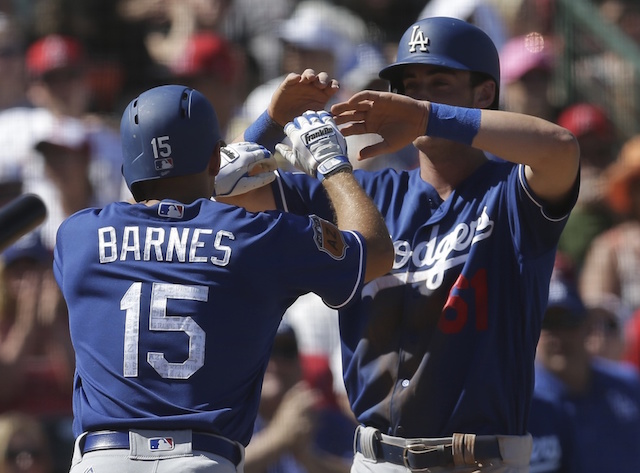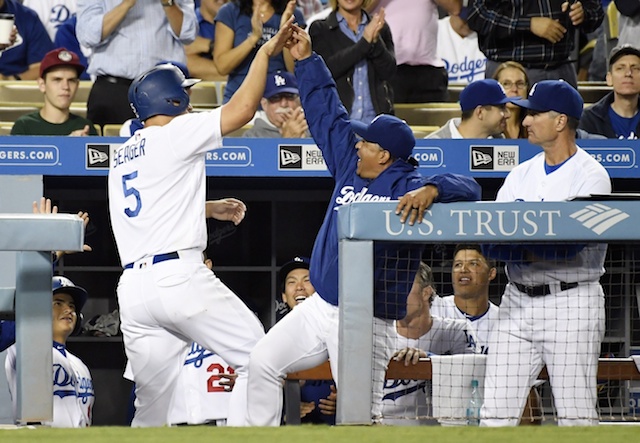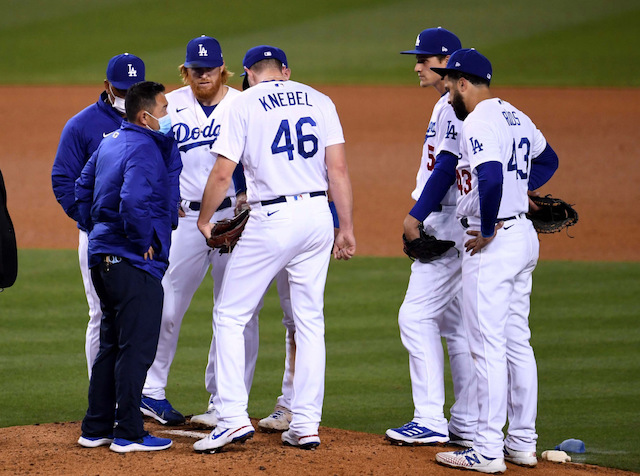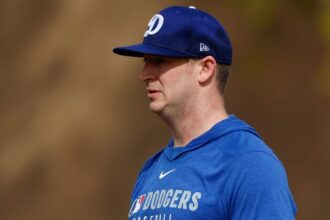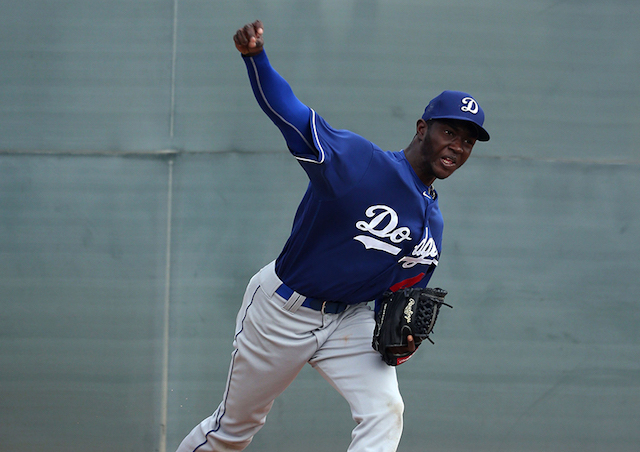
3. Walker Buehler, RHP
Buehler’s draft year didn’t get off to a great start. During his junior season in 2015, he was shut down with elbow issues in March but returned later in the spring. He lost his rotation spot to Vanderbilt senior lefty Phil Pfeifer, whom the Dodgers drafted in the third round that year, and pitched out of the bullpen during Vanderbilt’s College World Series run.
Buehler’s team lot to Virginia and series MVP Josh Sborz, who was another of the Dodgers’ 2015 Draft picks (second round).
It wasn’t all bad for Buehler, who was taken No. 24 overall in 2015. But soon, there would come some more bad news. A pre-draft physical revealed an injury to Buehler’s elbow that required Tommy John surgery. He was shut down and didn’t throw a professional pitch that year.
Cut to 2016 and things started getting better. Buehler worked his way back from and joined Low-A Great Lakes for his debut in July. He pitched in five games, including two starts in the playoffs for the Loons. While he only threw 10 innings, Buehler made a big impact.
When Buehler was at Vanderbilt, he generally sat in the low-to-mid 90s with his fastball. When he pitched with the Arizona League Dodgers and Great Lakes, he was sitting in the mid 90s. Now, he’s throwing 95-99 mph.
Buehler is not throwing more than a few innings at a time, but that’s still elite velocity for two or three inning stints. Along with the increased fastball velocity, the rest of his repertoire took a step forward. His cutter now resides in the low 90s, his changeup in the upper 80s and his curveball in the mid 80s. In limited time last year, he struggled to control his more explosive stuff.
Buehler is one of the most exciting prospects in baseball. His pure stuff rivals that of anyone in the Minors, though his limited innings could have something to do with that. He only pitched about 20 innings last season, including instructional league, and likely won’t eclipse 100 innings in 2017.
There’s also the issue of him staying healthy, as the greatest indicator of future health is past health. Buehler is likely to remain behind in extended Spring Training before heading out to an affiliate. His ability to hold his increased velocity, as well as remaining healthy, will be key in determining a future role.
Right now, Buehler looks like pre-injury Matt Harvey, and the Dodgers aren’t even letting him throw his cutter. He should dominate with his three-pitch mix and, health permitting, fly to the top of the Dodgers’ rotation in due time.
2. Cody Bellinger, 1B/OF
When the Dodgers selected Bellinger in the fourth round of the 2013 Draft, they got a skinny, slick defensive first baseman who didn’t hit for power. In his first two years as a professional, Bellinger had three times as many triples (12) as home runs (4).
However, as he grew into his body, he evolved as a player. In 2015, Bellinger came into camp bigger and stronger. He also jumped from rookie ball to High-A Rancho Cucamonga, skipping Low-A altogether.
Berlinger debuted as one of the youngest players in the California League at 19 years old. He then went on to hit 30 home runs. This, coming after hitting just four in 98 professional games the previous two seasons, cast a shadow of doubt on the young first baseman. Was his performance simply fueled by the hitter-friendly California League?
Last year, Bellinger went to Tulsa with something to prove. Mainly, that his power was for real. And that he did. He belted 23 home runs in just 114 games with the Drillers, then got a late-season promotion to Oklahoma City and bashed three more long balls in as many games.
After the season, he headed to the Arizona Fall League and hit .314/.424/.557 in 70 at-bats, also crushing a long home run in the Fall Stars game. Bellinger can hit the ball as far as almost anyone, but he’s not a one-trick pony.
Along with his double-plus power, he drastically improved plate discipline last year, reducing his strikeout rate last year by a whopping 7.4 percent while simultaneously increasing his walk rate by 3.1 percent.
While it’s a small sample, Bellinger has shown a willingness to shorten up and go the other way with two strikes during the spring. Defensively, Bellinger has Gold-Glove potential at first base.
He can pick balls out of the dirt with the best of them and is surprisingly agile for his size (6’4, 210-plus pounds). In fact, he’s so athletic, the Dodgers began putting Bellinger in center field in 2015, and he’s held his own there.
He’s an average runner who stole 18 of 22 bases over the past two years. While he’s not quite on the same level of prospect stardom as Corey Seager, Bellinger is a very good player in his own right.
The power will get him plenty of attention, but the elite defense at first base, ability to play the outfield and improving plate discipline will make him a very valuable player. He’ll begin 2017 back with OKC but should make his Major League debut sometime this season.
1. Yadier Alvarez, RHP
The crown jewel of the Dodgers’ 2015 international crop, Alvarez signed for $16 million as a 19-year-old out of Cuba. He never pitched in Cuba’s top league but was a hot commodity on the international market, as evidenced by his bonus.
I was able to get a look at Alvarez during Spring Training last year. His fastball sat mostly at 93 mph and he showed a solid slider and a few changeups. The potential was definitely there, as his listed size of 6’3 and 175 lbs. oozes projection.
After a stay at extended Spring Training, Alvarez headed to the Arizona League. He pitched in five games, struck out 26 batters in 20 innings and posted a 1.80 ERA. He then moved up to Great Lakes where he finished the season and won a championship, striking out 55 in 39.1 regular season innings with a 2.29 ERA.
Alvarez finished the year with 81 strikeouts in 59.1 innings, whiffing about a third of the batters he faced. The numbers are exciting, but his stuff is even better.
The right-hander’s fastball jumped into the mid-to-upper 90s and has started hitting triple digits with some regularity. What most impressive about his fastball isn’t simply that Alvarez throws it so hard, but that he does so with so little effort. It looks as if he’s playing catch.
The rest of Alvarez’s repertoire is exciting as well. He throws both a curveball and a slider, each earning occasional plus grades from scouts. His changeup gives him a solid fourth pitch that requires some development but should be average in time.
Alvarez’s delivery is slow and deliberate, which can cause timing issues when his top half doesn’t sync with his bottom half. However, he did a good job of throwing strikes while with the Loons, walking just 6.9 percent of batters faced.
With his lithe, athletic frame, electric fastball, promising secondaries and projectable command, Alvarez has the potential to be a top-of-the-rotation starter. The Dodgers limited his innings last year, as Alvarez pitched just over 70 frames if you include the postseason. He’ll likely be limited again this season, so if you get the chance to see him, take it.
You can listen to Jared on the weekly Dugout Blues Podcast



